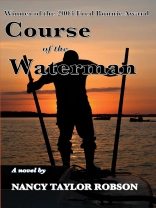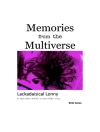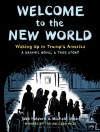Seventeen-year-old Bailey Kraft, descended from a long line of Chesapeake waterman — river royalty — knows where he is going. He will ‘follow the water like his father, grandfather, and generations of men before him. The work is backbreaking and often dangerous yet framed by the breathtaking beauty of the Chesapeake; it is a bred-in-the-bone life. But it is also a dying livelihood. Fish stocks are plummeting and with them, the harvests. Watermen, unable to earn a living, are being forced to give up their time-honored way of life. Yet Bailey is a Kraft—river royalty—with the Kraft gift for finding fish coded into his genes. He has a sense of purpose and belonging, until the day his father shatters his lifelong plans. Suddenly, he must fight the people he loves most, including his best friend, to hang on to his birthright. Set on the Chesapeake Bay’s Eastern Shore, Course of the Waterman is the coming-of-age story of Bailey Kraft; his tough and determined little sister, Hannah; his best friend, Booty; and Booty’s bitter, alcoholic father, Tud. Bailey faces fear, loss, and wrenching changes; yet amidst it all, he glimpses the unexpected possibilities that life can offer.
Like the Kraft men before him, Bailey has river water in his veins, and a peculiar talent for finding fish:
the Krafts are river royalty. But every year the haul is less
impressive, and supporting a family by fishing is becoming increasingly difficult. Early in the book Bailey’s father Orrin announces that he wants his son to go to college, to have options that he didn’t have. This change in plan is wholly unwelcome: Bailey had expected to fish full-time after finishing high school; he would have quit school to do so had he been allowed. But responding to his father’s bombshell is only the first of a great many challenges Bailey must meet in the course of the story–hard work in difficult, sometimes life threatening circumstances not least among them.
Bailey is surrounded by a handful of characters who are as vividly imagined as he is: his parents and younger sister and the Warrens, Tud and his son Booty, the latter more brother to Bailey than friend. R_obson, indeed, has fleshed out her characters and explored their interlocking relationships–all of which are changed during the course of this story–more fully than most authors can in twice as many pages. Robson’s book explores the obligations of friendship and the bonds, stronger than rivalries and animosities, that hold together a community of people who need one another to survive–‘the pull and haul of relationship, gift, and obligation.’
Like her characters, Robson grew up on the Chesapeake, and she worked for years as a deckhand on a coastal tug. (She tells her story in Woman in the Wheelhouse.) She couldn’t have written this book the way she did without that experience. Readers like myself who aren’t familiar with the life she describes–most of us, surely–will encounter some unfamiliar vocabulary here, but context is sufficient to get the meaning across. The first paragraph immerses the reader at once in the life of a Chesapeake waterman:
‘The trotline groaned over the roller as it came up out of the blue-black Elizabeth River on Maryland’s Eastern Shore. Braced against the boat’s wooden coaming, seventeen-year-old Bailey Kraft was poised, dip net ready, scanning for the bait twisted every eight feet or so into the mile-ong line. That was where the crab would be–if there were a crab. As he watched, a shadow rose from the dark water and came into focus, sharpening into olive shell and blue-green claws that clung to a frayed gray eel chunk tied to the line. When the crab broke the surface, Bailey leaned out, scooped it up, and dumped it into the bushel basket at his feet.’
Sobre el autor
Nancy Taylor Robson, one of the first women in the country to earn a US Coast Guard license to run coastal tugs, grew up sailing and building boats with her dad on the Chesapeake Bay. IN addition to Course of The Waterman, she is the author of three other books, including Woman in the Wheelhouse (Tidewater Publishing 1985/Head to Wind Publishing 2013) about the six years she worked on coastal tugboats, first as cook/deckhand then as licensed mate, A Love Like No Other: Abigail and John Adams, A Modern Love Story, which takes the reader through the tumultuous, passionate and challenging life and lifelong love of Abigail Adams, and OK Now What? A Caregiver’s Guide to What Matters, which she wrote with RN and longtime hospice nurse, Sue Collins while her mother-in-law was dying.Robson has been a freelance writer for decades. She has written numerous travel articles for Yachting, The Baltimore Sun, Southern Living, Chesapeake Leisure, and Coastal Living. She wrote garden articles for House Beautiful and for ten years wrote bi-monthly garden articles for The Baltimore Sun as well as occasional garden pieces for Washington Gardener, Garden Solutions, and The Maryland Hort Report. Her essays have appeared for many years in The Christian Science Monitor; one is reprinted in Chicken Soup for The Couple’s Soul, another in Short Model Essays: Patterns and Subjects for Writing, 2nd Ed., as well as Catholic Digest and The Washington Post. She has written numerous articles on the environment for The Baltimore Sun, Chesapeake Bay Magazine (for which she is also a contributing writer), Southern Living, Maryland Magazine, and Work Boat, Woodenboat, Annapolis Magazine, and Sail. She has written features, travel, profiles, culture, maritime analysis, reportage, and personal essays. The author, a University of Maryland Master Gardener and Bay-Wise certifier, has been gardening for 45 (in patio pots, college dorm room, a couple of apartment balconies during her barely-adulthood), on 1/3 acre for eleven years where she grew blueberries, raspberries, dewberries, vegetables, ornamentals, and herbs and for the past 20 on two acres on Maryland’s Eastern Shore where she grows vegetables, fruit, nuts, ornamentals, herbs, and more. She wrote for the UMD Extension’s Grow It Eat It blog for several years. She is a long-time member of the international Garden Writers of American (now Garden Comm) and has been on the association’s Sustainability Committee since its inception. She is particularly interested in planting for pollinators, including birds, so she won’t have to take special measures to feed them or hand-pollinate her crops (as they must do now in many parts of China and some parts of the US). She has done book signings and talks for each of her books, a book tour for the Course of The Waterman and lectures and presentations on her work in a variety of venues.












